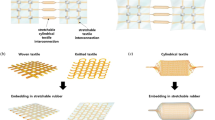Abstract
We developed the stretchable wiring made from oriented short conductive fibers and applied it to a stretchable pressure sensor. The short fibers were mechanically oriented on an elastic substrate/film across the long wiring axis of wiring. The stretchable wiring with 5 mm in width had 17.0 Ω in initial resistance per 1 cm in length and the change in its resistance was only 214 % at 100 % elongation. Even if the wiring is stretched in the long axis direction, the short fibers form junctions with other fibers, thereby retaining their electric conductivity. A stretchable pressure sensor sheet, which is sensitive to pressure in the vertical direction and insensitive to elongation in the horizontal direction, was also successfully developed using the stretchable wiring and elastomer films. These sensor cells sensitively measured the pressure up to ca. 64 kPa. This sensor sheet was demonstrated as a shoe insole pressure sensing system and the sensor system could detect a pressure distribution from soles to adapt to its deformation.






Similar content being viewed by others
References
Arcelus A, Veledar I, Goubran R, Knoefel F, Sveistrup H, Bilodeau M (2011) Measurements of sit-to-stand timing and symmetry from bed pressure sensors. IEEE Trans Instrum Meas 60:1732–1740
Nishyama M, Miyamoto M, Watanabe K (2011) Respiration and body movement analysis during sleep in bed using hetero-core fiber optic pressure sensors without constraint to human activity. J Biomed Opt 16:017002
Suutala J, Röning J (2008) Methods for person identification on a pressure-sensitive floor: experiments with multiple classifiers and reject option. Inf Fusion 9:21–40
Kim H, Chang S (2013) High-resolution touch floor system using particle swarm optimization neural network. IEEE Sens J 13:2084–2093
Wu X, Rakheja S, Boileau PÉ (1998) Study of human–seat interface pressure distribution under vertical vibration. Int J Ind Ergon 21:433–449
Ashruf CMA (2002) Thin flexible pressure sensors. Sens Rev 22:322–327
Marenzi E, Bertolotti GM, Cristiani A (2013) Design and development of a monitoring system for the interface pressure measurement of seated people. IEEE Trans Instrum Meas 62:570–577
Uemura S, Watanabe Y, Yoshida M, Tokuhisa H, Takada N (2013) Pressure sensor array fabricated with polyamino acid. J Photopolym Sci Technol 26:411–414
Watanabe Y, Uemura S, Hoshino S (2014) Printed pressure sensor array sheets fabricated using poly(amino acid)-based piezoelectric elements. Jpn J Appl Phys 53:05HB15
Lacour SP, Benmerah S, Tarte E, FitzGerald J, Serra J, McMahon S, Fawcett J, Graudejus O, Yu Z, 3rd Morrison B (2010) Flexible and stretchable micro-electrodes for in vitro and in vivo neural interfaces. Med Biol Eng Comput 48:945–954
Guo R, Yu Y, Xie Z, Liu X, Zhou X, Gao Y, Liu Z, Zhou F, Yang Y, Zheng Z (2013) Matrix-assisted catalytic printing for the fabrication of multiscale, flexible, foldable, and stretchable metal conductors. Adv Mater 25:3343–3350
Yan C, Kang W, Wang J, Cui M, Wang X, Foo CY, Chee KJ, Lee PS (2014) Stretchable and wearable electrochromic devices. ACS Nano 8:316–322
Liu CH, Yu X (2011) Silver nanowire-based transparent, flexible, and conductive thin film. Nanoscale Res Lett 6:75
Han S, Hong S, Ham J, Yeo J, Lee J, Kang B, Lee P, Kwon J, Lee SS, Yang MY, Ko SH (2014) Fast plasmonic laser nanowelding for a cu-nanowire percolation network for flexible transparent conductors and stretchable electronics. Adv Mater 26:5808–5814
Kim S, Byun J, Choi S, Kim D, Kim T, Chung S, Hong Y (2014) Negatively strain-dependent electrical resistance of magnetically arranged nickel composites: application to highly stretchable electrodes and stretchable lighting devices. Adv Mater 26:3094–3099
Feng C, Liu K, Wu JS, Liu L, Cheng JS, Zhang Y, Sun Y, Li Q, Fan S, Jiang K (2010) Flexible, stretchable, transparent conducting films made from superaligned carbon nanotubes. Adv Funct Mater 20:885–891
Tadakaluru S, Thongsuwan W, Singjai P (2014) Stretchable and flexible high-strain sensors made using carbon nanotubes and graphite films on natural rubber. Sensors 14:868–876
Kim T, Song H, Ha J, Kim S, Kim D, Chung S, Lee J, Hong Y (2014) Inkjet-printed stretchable single-walled carbon nanotube electrodes with excellent mechanical properties. Appl Phys Lett 104:113103
Jeong JW, Yeo WH, Akhtar A, Norton JJS, Kwack YJ, Li S, Jung SY, Su Y, Lee W, Xia J, Cheng H, Huang Y, Choi WS, Bretl T, Rogers JA (2013) Materials and optimized designs for human-machine interfaces via epidermal electronics. Adv Mater 25:6839–6846
Ahn BY, Duoss EB, Motala MJ, Guo X, Park SI, Xiong Y, Yoon J, Nuzzo RG, Rogers JA, Lewis JA (2009) Omnidirectional printing of flexible, stretchable, and spanning silver microelectrodes. Science 323:1590–1593
Kim DH, Liu Z, Kim YS, Wu J, Song J, Kim HS, Huang Y, Hwang K, Zhang Y, Rogers JA (2009) Optimized structural designs for stretchable silicon integrated circuits. Small 5:2841–2847
Kim DH, Song J, Choi WM, Kim HS, Kim RH, Liu Z, Huang YY, Hwang KC, Zhang Y, Rogers JA (2008) Materials and noncoplanar mesh designs for integrated circuits with linear elastic responses to extreme mechanical deformations. Proc Natl Acad Sci 105:18675–18680
Verplancke R, Bossuyt F, Cuypers D, Vanfleteren J (2012) Thin-film stretchable electronics technology based on meandering interconnections: fabrication and mechanical performance. J Micromech Microeng 22:015002
Guo CF, Sun T, Liu Q, Suo Z, Ren Z (2014) Highly stretchable and transparent nanomesh electrodes made by grain boundary lithography. Nat Commun 5:3121
Choi WM, Song J, Khang DY, Jiang H, Huang YY, Rogers JA (2007) Biaxially stretchable “wavy” silicon nanomembranes. Nano Lett 7:1655–1663
Choong CL, Shim MB, Lee BS, Jeon S, Ko DS, Kang TH, Bae J, Lee SH, Byun KE, Im J, Jeong YJ, Park CE, Park JJ, Chung UI (2014) Highly stretchable resistive pressure sensors using a conductive elastomeric composite on a micropyramid array. Adv Mater 26:3451–3458
Author information
Authors and Affiliations
Corresponding author
Rights and permissions
About this article
Cite this article
Nobeshima, T., Uemura, S., Yoshida, M. et al. Stretchable conductor from oriented short conductive fibers for wiring soft electronics. Polym. Bull. 73, 2521–2529 (2016). https://doi.org/10.1007/s00289-016-1680-9
Received:
Revised:
Accepted:
Published:
Issue Date:
DOI: https://doi.org/10.1007/s00289-016-1680-9




